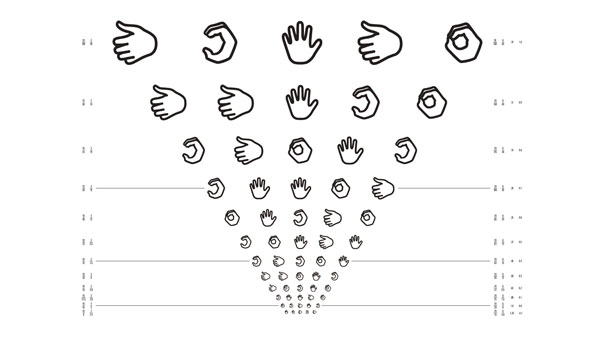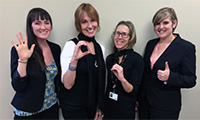Handy Eye Chart
An All-Inclusive Visual Acuity Test
As a teacher for visually impaired students, Cindy Lou Harrington found that she didn't always trust the results that came back from her student's vision tests. "I had kids who didn't speak English, or had cerebral palsy or multiple impairments," says Harrington, who taught for nearly three decades in DeKalb and Fulton County schools. "The regular eye testing charts didn't work for them."
In fact, she came across several children who had been completely misdiagnosed: a boy diagnosed as learning disabled who actually had severe nystagmus and was legally blind; a shy 5-year-old Asian girl who had been thought of as blind but actually had good vision. This led to misguided educational interventions and a failure in treating the actual visual impairment.
So Harrington decided to create her own test that even nonverbal students could easily perform—not only that, she wanted to make it fun. To that end, she developed the "Thumbs Up" test, to assess functional vision. This test used pictures of common hand gestures that her nonverbal students could mimic.

Handy Eye Chart
She also started going to eye exams with her students, watching how they were tested and learning more about their eye problems. "I get very passionate about helping my kids," she says. Fortuitously, during these exams, Harrington met Emory pediatric ophthalmologist Amy Hutchinson and approached her about working together to refine her functional assessment tool into a valid test of visual acuity.
Hutchinson and then-medical student Caroline Cromelin expanded on Harrington's idea to use hand gestures as a functional assessment of vision. They came up with the Handy Eye Chart™, a formal test of visual acuity that conformed to accepted standards for visual acuity charts. They validated the chart by comparing it to a gold standard eye chart on children age 6 to 18 who were visiting the Emory Eye Center.
Since then, with the help of Emory medical student J.P. Gorham, they have tested the chart in a number of settings, including a population of students at the Atlanta Area School for the Deaf. In the May 2016 issue of the Journal of AAPOS (American Association for Pediatric Ophthalmology and Strabismus,) they shared results from the study: testing with the Handy Eye ChartTM was faster, preferred by the majority of students, and valid. Another article, published in the Journal of the American Academy of Ophthalmology, suggested that the Handy Eye Chart™ "might also aid in the visual acuity screening of children with language delay, who are shy, or who have aphasia."
"The chart was well received, and the children really liked it a lot," says Hutchinson. "The other place we think it will really be helpful is in some international settings."

Taylor Estes, Cindy Lou Harrington, Amy Hutchinson, Caroline Cromelin
"It has been really inspiring to work with Cindy, Amy, Caroline, and the Groundwork Go team on this project," says Clifford Michaels, assistant director of Emory's Office of Technology Transfer. "There has been a real, true passion to help others and make a difference behind each stage of the chart's development; it is infectious. I'm excited for everyone involved that we have reached the point where the product is now available for purchase, and look forward to seeing where the team takes it next."
The inventors of the chart would like to see the test go digital, with versions for computer and tablet screens. And while the Handy Eye Chart™ hasn't been tested in children under 6, Harrington feels that is a group for which the test is a natural fit. "We already have a song and a little game with their hands to teach them how to use it," she says, adding that the siblings of children being tested have spontaneously wanted to take part. "It feels like play to them."
Technology still available for licensing: see our technology brief.
Techid: 11144